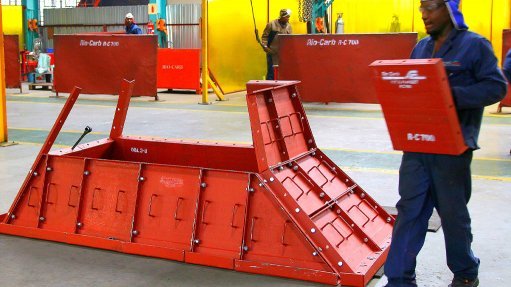Is your building intelligently supporting your well-being?
This article has been supplied by the author and has not been written or solicited by Creamer Media. It may be available only for a limited time on this website.
By Thabang Byl, Buildings Segment Lead at Schneider Electric
Buildings are gathering places for humans, and for its inhabitants to prosper, it needs to be sustainable, resilient and people centric. It is also this people centricity that requires buildings to be healthy. In fact, studies have consistently shown that healthier buildings lead fewer sick days.
The reality is building will always have to deal with outbreaks like the seasonal flu and other infectious diseases whilst maintaining an overall healthy, productive environment. Building operators and owners must therefore be cognisant of the health of building to ensure the wellbeing of occupants as well as mitigate potential productivity loss.
To this end, building health certifications have over the year gained some important traction, emphasising the importance of creating healthier indoor environments, promoting wellbeing. For example, the WELL Building Standard, developed by the International WELL Building Institute (IWBI), focuses on enhancing human health and well-being within buildings, encompassing categories such as air, water, nourishment, light, fitness, comfort and mind.
Building Management Systems (BMS) and related smart building technologies have an important part play in putting an end to the colloquial “sick building syndrome”. Building controls can assist in simplifying, improving and automating safe and healthy buildings.
Making buildings smart, and healthier
In South Africa, smart buildings can simplify compliance with both legislative frameworks and voluntary certifications aimed at improving building health and safety. Together with WELL, the LEED (Leadership in Energy and Environmental Design) rating system also considers indoor environmental quality.
Connected devices track everything from room comfort parameters to indoor air quality such as CO2, VOC (volatile organic compounds) as well as daily people movement. Every aspect of power conditions and energy consumption is also accurately measured and analysed.
Driven by these inputs, building health and performance can be automatically optimised in a responsive and unified way.
For example, if a rise in CO2 and/or increased density of people is detected, the BMS will respond by increasing ventilation in that zone. The opposite will also be true; a low occupancy zone will trigger the BMS to reduce ventilation as well as reduce heating, cooling, or lighting to save on energy.
Here, indoor health is balanced with buildings’ efforts to run more efficiently and be environmentally sensitive.
The same network of VOC and occupancy sensors can ensure building maintenance crews clean the right places at the right time, helping ensure safety while optimising time and costs.
Also, the newest integrated employee engagement apps can keep employees informed of ‘safe’ areas to help avoid overcrowding, give them touch-free control over room comfort, and enable efficient meeting room booking. These and other convenient functions can all translate to gains in productivity.
Beyond these capabilities, the newest smart building solutions use continuous data collection and analytic tools to simplify building health and performance reporting. Reports can be regularly shared with third-party testing and building certification organisations.
Schneider Electric’s EcoStruxure Building collaborative IoT solutions help drive greater visibility and improvement of all aspects of building operations to assist owners’ facility managers realise healthier operations.
Comments
Press Office
Announcements
What's On
Subscribe to improve your user experience...
Option 1 (equivalent of R125 a month):
Receive a weekly copy of Creamer Media's Engineering News & Mining Weekly magazine
(print copy for those in South Africa and e-magazine for those outside of South Africa)
Receive daily email newsletters
Access to full search results
Access archive of magazine back copies
Access to Projects in Progress
Access to ONE Research Report of your choice in PDF format
Option 2 (equivalent of R375 a month):
All benefits from Option 1
PLUS
Access to Creamer Media's Research Channel Africa for ALL Research Reports, in PDF format, on various industrial and mining sectors
including Electricity; Water; Energy Transition; Hydrogen; Roads, Rail and Ports; Coal; Gold; Platinum; Battery Metals; etc.
Already a subscriber?
Forgotten your password?
Receive weekly copy of Creamer Media's Engineering News & Mining Weekly magazine (print copy for those in South Africa and e-magazine for those outside of South Africa)
➕
Recieve daily email newsletters
➕
Access to full search results
➕
Access archive of magazine back copies
➕
Access to Projects in Progress
➕
Access to ONE Research Report of your choice in PDF format
RESEARCH CHANNEL AFRICA
R4500 (equivalent of R375 a month)
SUBSCRIBEAll benefits from Option 1
➕
Access to Creamer Media's Research Channel Africa for ALL Research Reports on various industrial and mining sectors, in PDF format, including on:
Electricity
➕
Water
➕
Energy Transition
➕
Hydrogen
➕
Roads, Rail and Ports
➕
Coal
➕
Gold
➕
Platinum
➕
Battery Metals
➕
etc.
Receive all benefits from Option 1 or Option 2 delivered to numerous people at your company
➕
Multiple User names and Passwords for simultaneous log-ins
➕
Intranet integration access to all in your organisation





















